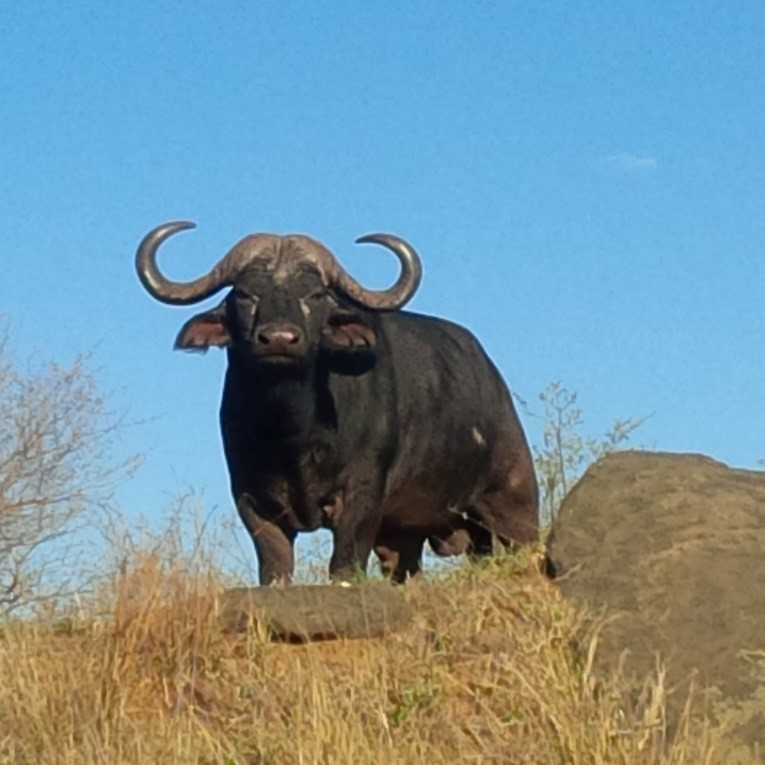Global Disease Detection Stories: Tracking and Taming Zoonotic Diseases in South Africa
A One Health program in South Africa connects physicians and veterinarians to better understand causes of human disease by looking at animals in a new light.

Collecting samples from African buffalo in Kruger National Park.
How do you tonsil swab a wild African buffalo? More importantly, why? The answer is that buffaloes are reservoirs for certain “zoonotic” diseases, or diseases that can be passed from animals to humans. Many infectious diseases (such as rabies and Rift Valley Fever) are transmitted through animals, which is why tracking animal diseases that could potentially jump to humans is a crucial aspect of public health. Early detection means spotting these diseases in animals before they make people sick.
Tracking disease in a national park
Dr. Marietjie Venter of the Global Disease Detection program in South Africa, visited Kruger National Park along with Jumari Steyn, a PhD student from the University of Pretoria. As part of a wildlife surveillance program, a skilled group of veterinarians sampled 30 buffalo in three hours. They swabbed tonsils and collected blood, fecal, and stomach content to investigate foot and mouth disease (FMD), which can cause major outbreaks in cattle if they come into contact with infected buffalo.
“Early detection means spotting diseases in animals before they make people sick.”
While buffalo are natural reservoirs for FMD, they are also thought to carry Rift Valley Fever, bovine tuberculosis, and other bacteria and viruses that could potentially spread to humans. The University’s research unit will use the collected samples to investigate for these zoonotic diseases which have been detected in wildlife, farm animals and humans.
An expanded partnership between the Centers for Disease Control and Prevention (CDC) South Africa and the University’s research unit improves surveillance capacity to include priority zoonotic diseases in the region: anthrax, brucellosis, rodent- and bat-borne pathogens, and many others. It also adds additional data collection sites and enhances reporting.
Bridging animal health and human health
Tracking diseases in domestic animals and wildlife has been happening for a long time, but linking that information to humans who are sick or could become sick has not. South Africa has strong surveillance systems; CDC’s role has been to support and expand them through its One Health program.

Buffalo are natural reservoirs for foot and mouth disease.
While it makes sense to get human and animal experts together, this is not an easy task. The One Health initiative has programs all over the world and builds bridges between people who may not otherwise work together. The success of the program lies in the regularity of the exchanges. One Health programs explores connections between human health, animal health, and the environment, bringing together experts in fields as diverse as climate change, farming practices, and wildlife management. According to Dr. Wanda Markotter, the Principal Investigator for CDC’s original agreement with the University of Pretoria, “This new project will significantly enhance the collaboration between the Health and Veterinary faculties to develop joint surveillance and diagnostic programs on zoonotic disease in South Africa and provide feedback to the Ministries of Health and Agriculture in South Africa.”
So back to that buffalo. Are you curious about how those specimens are collected?
Step 1: Tranquilizer dart.
Step 2: Apply blindfold.
Step 3: Drag with tractor to recovery area.
Step 4: Collect sample.
Step 5: Provide tranquilizer antidote.
Step 6: Run! Doctors treating humans may want to count their blessings.
A cooperative agreement between CDC and the University of Pretoria’s Zoonoses Research Unit is expanding zoonotic disease surveillance in South Africa. This work is coordinated through the GDD Center in South Africa, which is part of CDC’s country office.
- Page last reviewed: December 8, 2015
- Page last updated: December 8, 2015
- Content source:


 ShareCompartir
ShareCompartir